It was in 1851 that Victoria became a colony with its own Parliament. Prior to this Victoria was a part of the New South Wales Colony. In 1849 a lease was granted by the NSW Governor, to Thomas Walton of Buckinghamshire for about 9000 hectares of land comprising what we now know as Longwarry North and Labertouche. In 1851 this lease was passed to a H. Jennings and it became known as the Buneep Run from which the name Bunyip originates.
About 15kms to the south of what is now Longwarry along the Modella/Kooweerup Road, Messrs. Connor and Mulchay were granted a pastoral lease for The Longwarry Pastoral Run in 1855. This lease seems to have had two other names, Heifer Creek Run and Musk Creek Run, which were two creeks with in the leased area. The Buneep and Longwarry leases were running beef cattle.
Both these runs were granted leases under an 1847 Land Leasing or licencing Act, which was a move to legalise and gain some control over the vast amounts of land being occupied by Squatters, particularly in the western part of Victoria.
The Squatter selections had locked up much of the good land on which they were running sheep for wool to send back to the wool mills in England. The Squatters were wealthy and had considerable political power so it wasn’t possible nor was there the political will to wind back these holdings.
With the gold rushes of the 1850’s Victoria’s population exploded and enormous sums of money were flooding into the Colony’s Treasury.
These new comers had to be fed and they couldn’t eat wool, so land had to be opened up to farming and the first Land Act of 1860 came into being. It allowed people to take up smaller acreages for the purpose of farming for which they paid a lease fee with a view to purchasing the allotment.
Several land Acts followed throughout the 1860’s and the Act of 1869 came about, just as roads and communications were opening up in the Longwarry District, settlers took advantage of the Act to select properties and began farming around Longwarry.
Under this 1869 Act up to 320 acres (130 hectares) could be leased. The rent was set at two shillings (20 cents) per acre and on application; a deposit of half a year’s rent was paid. If the application was refused, the deposit was refunded. Conditions on the three-year licence required selectors to improve their allotment by the erection of fencing and a dwelling, cultivation of their land and the destruction of vermin and noxious weeds. After the licence term had expired, the selector was eligible to apply for a seven-year lease or for a Crown Grant to purchase their allotment. Grants or leases were only approved if improvement conditions had been met. If a selector opted for a seven-year lease, the yearly rent was used to pay off the purchase price of the land. Rent previously paid was credited against the purchase price.
There were amendments to this Act several times in the 1870s but the main thrust of what was intended remained the same for the farming land taken up around the Longwarry District.
The discovery of gold at Walhalla in 1862 created the need for a road and the Sale Road along what was the Old Telegraph Road was built in 1865. This is what we now know as the Princes Highway as far as Drouin West.
Names that we know who held land leases around the immediate township area were P. Thompson who held a lease along Corduroy Road which he later subdivided.
Possibly the earliest settlers to the south of the town were the Gardners and Pembertons in 1873, with further selections by Osborne, Stone, Wallace. McDermid, Wilson, Hanlon, Sullivan and Murdoch.
However it was the decision to build a railway line through Gippsland that began the townships along the rail line.
It was decided to construct a railway from Oakleigh to Sale in stages, the construction began from both ends and the part that concerns us reached Bunyip in October 1877 and the next stage to cross the Bunyip River commenced, finally the first train crossed the river on March 1st. 1878.
A railway camp of construction men, their wives and children was set up at The Rock Cutting east of what is now the town; it was accessed via Hammond Road which runs off the Drouin/Longwarry Road.
Along the railway line small groups of sleeper cutters and other workmen set up camps their houses were generally bark and wood slab constructions. For convenience these camps often occurred where a road met the rail line.
For us there was just such a road, it was The Yannathan Road which ran from the Sale Road (now The Princes Highway) out towards the swamp. The reader will know the Yannathan Road better as Sand Road/Princes Ave. as far as the railway gates in Longwarry and the Modella/Kooweerup Road on the other side of the line.
This intersection was simply known as The Crossing or by some as The Siding, the land either side of the railway line where the sleeper cutters built their small houses was Crown land and to have some control or form of ownership over the land they had built on, these men took out miner’s rights.
Of course this meant there was virtually no control or planning over where people put up their houses, it was a very haphazard community with virtually no roads or access points and no clear ownership of property.
This did not please the Shire, nor did it suit the first business to arrive in the area which was when Donald Fraser moved his sawmill from Drouin to The Siding in 1881 (you can read this story elsewhere on the website). This mill was on the corner of what is now Witton Street and Drouin Road.
No doubt many of you know that before the township of Longwarry was surveyed and named in 1886 its name had changed from The Siding to Fraser Siding.
Fraser was threatened with legal action for setting up on Crown Land and so action began to have a survey done to establish allotments that could be bought. It was also in his own interests to have this done, so that he could be guaranteed access to the railway siding.
This was done and signed off in July 1881 and an attempt to accommodate the houses that were already on land held under Miners Rights was made.
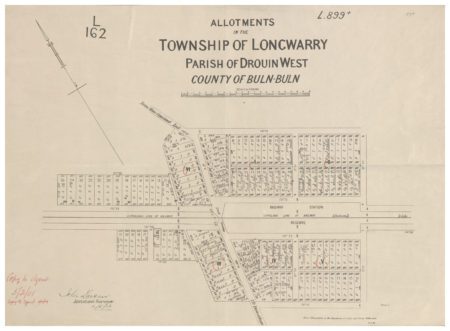
However a subsequent survey was done in 1886 (above) and this, as far as the authorities were concerned, better established the boundaries and gave an official lay out of the town and is regarded as the first survey of what we would now recognise as Longwarry Township.
This is a jpeg image the original 1886 survey that defined the township area. It can be enlarged using any of your usual programs which will enable you to read the names.
This survey shows some 98 blocks of land of which 47 had been purchased and a close inspection from enlarging the jpeg image allows us to identify that the following 26 people held the title to the 47 blocks. Those who had more than one title have the number they owned in brackets
T.L. Pemberton (9) Mary Fraser (3) Donald Fraser (2)
Jas Rhodes (2) E. Ordy ? E. M. Peck
Leo Cohen ? Stone W. Anderson
Gustave Beer (2) Louisa McRae (3) Julia O’Brien
B. Browne D & J Kennedy E. Southhorn
T. Bourke (2) ? Cannon Wm. Cotrie
T. Stone Jas Jeffries R. Witton
Jacob Bower (4) W.M.Vale (4) R. Hall
James Massey E. Peters
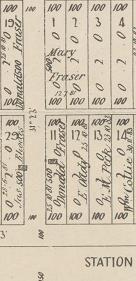
Enlarged section along Drouin Rd. between Mackey St. and Church St.
Above is an enlarged section along Drouin Road past Witton Street, to give the reader an idea of how this survey appears in larger format. You can identify Donald Fraser’s mill site on the corner of Witton Street where the Union Church now stands. Directly across the Drouin Road his wife Mary has another two blocks and Fraser has another below this, on the corner of Mackey Street and Drouin Road, which gives him clear access to the railway siding for the transport by rail of his timber. His tram line ran through these blocks.
The word station indicates the actual position of the first railway station/siding which is opposite the corner of Bennett Street and McRae Street.
In 1884 the second significant industry came into town with E. W. Witton Brickworks. Located around what is now the Factory site, many older residents might remember the water hole at the back of the factory. This was actually dug out as the clay pit for Witton’s bricks.
The brickworks had all the up to date digging and drying equipment as a newspaper report below from 1986 indicates.
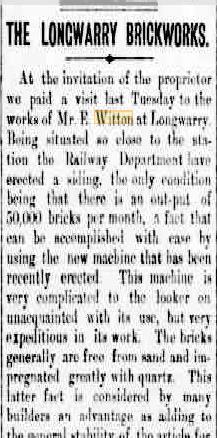
It was capable of producing 100,000 bricks per month at capacity and a contract for 250,000 bricks is reported in this newspaper article. Witton also had direct access to the railway siding for the transport of his bricks.
Buildings and houses throughout the District, including Drouin and Warragul, were built with Witton’s bricks and we understand that the bricks in the old section of the Warragul Hospital came from Longwarry.
Around the turn of the century we know from statistics that some 400 men were employed in and around the town, unfortunately Government census data is not available to provide more detail.
We know that some of the early townspeople operating businesses were Allanson, a saddler, near where the Union Church is now. The first milk supply for the town was from a goat herd operated by a Mrs. Green, W. Cowans owned a store of mixed business, J. Jeffers had another mixed business store in Mackey Street, Emil Frylock was the baker’s boy from Snell’s Bakery located out on The Sale Road. He would ride his bicycle into the town and deliver bread.
This bakery served the town for a long time until Tom Maisey opened a bakery in the town, Folwell was the baker around 1900, and A. Noble was the baker in 1910. In the 1920’s it was owned by Gracey and then Hardie, Sinnett, Walker and Martin. (It is fair to assume that Sinnett is the same family well known for their bakery in Warragul years later.)
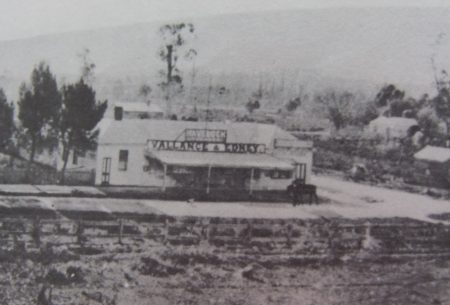
Valance & Edney Store Cnr. Mackey Street and Drouin Rd. 1905
Valance and Edney had a store on the corner of Mackey Street and Drouin Road (photograph above) and Alf Sherrif was the blacksmith/saddler a little further along the street
Of course with horse power of the 4 legged variety as the main form of transport, and blacksmiths were a very important businesses. Mr. A Bruton, followed by his son Alan and A. W. Ford had blacksmith forges. Alan Bruton was the last Longwarry blacksmith, his forge was on the site of what many will know as Perc Eacott’s garage.
Other stores operating in the town along Mackey Street were owned by Miss Jeffers, the newsagent was first owned by McMillans and was located exactly where many of us will know it today..
Opposite McMillan’s newsagency, on what is now a vacant block, Charlie Hickford formerly a tram driver for Freeman’s saw mills, had a shoe repair shop in the late 1930’s.
We know from a recent recorded interview with 93 year old former resident, Mr. Ossie Rosenquist, that as late as 1930 there were few businesses either side of Mackey Street, with residential buildings and vacant blocks interspersed amongst them. This recorded interview will be posted on the Website in coming months.
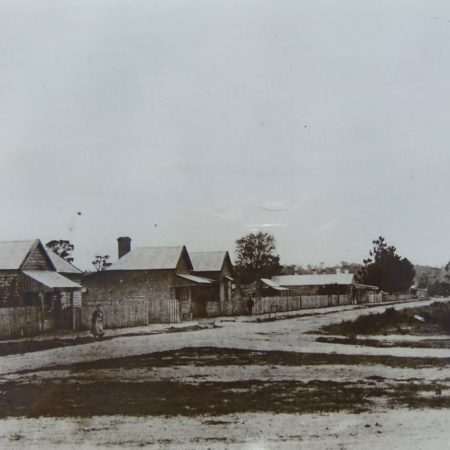
Mackey Street 1900
Those who can remembers Laurie Edwards milk bar across from the Bowling Green will not be surprised to know that this was also a very early building in the town and was operated by the McAlpines. It was a billiard hall and “milk bar” very much as Laurie operated many years later.
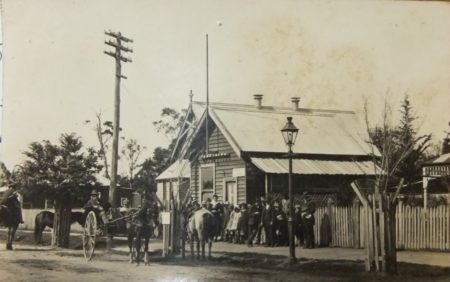
Bains Post Office 1915
The first Post Office was operated from the railway station by Mr. Woodlands, later a Post Office was built on, or close, to the Catholic Church site and this was operated by Bains. (See photograph above – 1915)
In the early 1900’s there were two hotels in Longwarry, one owned by Kennedy on its current site and his opposition set up directly across the road on the corner of Kennedy Street and Flinders Road. This hotel burnt down and a grocers shop was built in its place by a Mr. Frome, Hoopell later owned this shop (see photograph right), followed by a Mr. Watson and Martin. Of course so many of us well remember Martin’s store with the lovely Miss Hall selling the haberdashery.
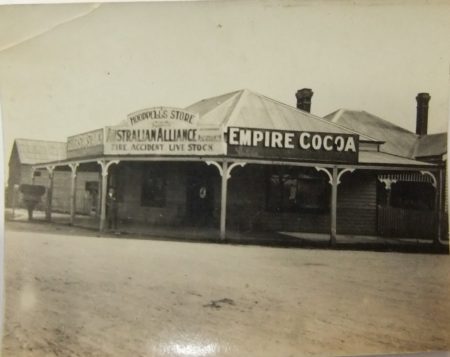
Hoopell’s Store Cnr. Kennedy St & Flinders Rd. c1930
A series of butchers operated in the town with names such as Neale, Stone, Burke, Rhodes, and Walker. Long-time butchers were the Toy family and in the 1930’s Stan Peterson was supplying meat.
Squire Goodwin had a carrier business around the turn of the century as did the Norton family.
Longwarry also had a police station in the very early part of the century in Witton Street beside, what is now the Union Church. The first police constable was Constable Canty, followed by Constables Reilly and Ryan.
In the mid 1890’s a sports track was built from the railway gates down what is now Kennedy Street and past the hall. We have very little information about what this was used for and for how long. It must have run alongside the street as we know that the survey of 1886 had allocated blocks of land either side of the road.
More research is needed on this and we hope we can give more information of this, in our next chapter about the history of the town, as we move past the 1930’s.
We will continue the story of the township at a later time.
We gratefully acknowledge the work of Mr. Clarrie McDermid in “A Brief History Of Longwarry” for The Back-to-Longwarry Committee. (1964) for sections of this work.
Comments